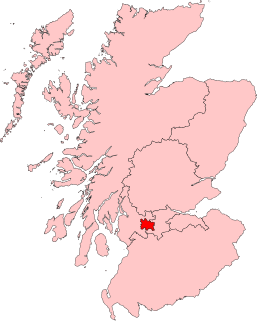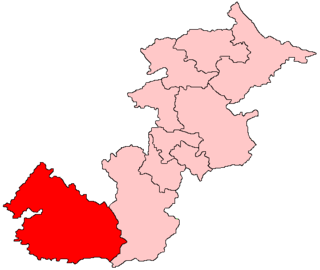
Glasgow is one of the eight electoral regions of the Scottish Parliament. Nine of the parliament's 73 first past the post constituencies are sub-divisions of the region and it elects seven of the 56 additional-member Members of the Scottish Parliament (MSPs). Thus it elects a total of 16 MSPs.

The Lothians was one of the eight electoral regions of the Scottish Parliament (Holyrood) from 1999 to 2011. Nine of the parliament's 73 first past the post constituencies are sub-divisions of the region and it elects seven of the 56 additional-member Members of the Scottish Parliament (MSPs). Thus it elects a total of 16 MSPs.

Mid Scotland and Fife is one of the eight electoral regions of the Scottish Parliament which were created in 1999. Nine of the parliament's 73 first past the post constituencies are sub-divisions of the region and it elects seven of the 56 additional-member Members of the Scottish Parliament (MSPs). Thus it elects a total of 16 MSPs.

The Scottish Parliament (Constituencies) Act 2004 is an Act of the Parliament of the United Kingdom that amends the Scotland Act 1998 which established the Scottish Parliament.

In the United Kingdom (UK), each of the electoral areas or divisions called constituencies elects one member to the House of Commons.

Caithness, Sutherland and Easter Ross was a constituency of the Scottish Parliament (Holyrood), in use between 1999 and 2011. It elected one Member of the Scottish Parliament (MSP) by the first past the post method of election. Also, however, it was one of eight constituencies in the Highlands and Islands electoral region, which elects seven additional members, in addition to eight constituency MSPs, to produce a form of proportional representation for the region as a whole.

East Lothian is a constituency of the Scottish Parliament (Holyrood). It elects one Member of the Scottish Parliament (MSP) by the plurality method of election. Also, however, it is one of nine constituencies in the South Scotland electoral region, which elects seven additional members, in addition to nine constituency MSPs, to produce a form of proportional representation for the region as a whole.

Livingston was a constituency of the Scottish Parliament (Holyrood). It elected one Member of the Scottish Parliament (MSP) by the plurality method of election.

West of Scotland was one of the eight electoral regions of the Scottish Parliament that were created in 1999. Nine of the Parliament's 73 first past the post constituencies were sub-divisions of the region and it elected seven of the 56 additional-member Members of the Scottish Parliament (MSPs). Thus it elected a total of 16 MSPs.

Glasgow Maryhill was a constituency of the Scottish Parliament (Holyrood). It elected one Member of the Scottish Parliament (MSP) by the plurality method of election. However, it was also one of ten constituencies in the Glasgow electoral region, which elects seven additional members, in addition to ten constituency MSPs, to produce a form of proportional representation for the region as a whole.

Cumbernauld and Kilsyth is a constituency of the Scottish Parliament (Holyrood). It elects one Member of the Scottish Parliament (MSP) by the plurality method of election. Also, however, it is one of nine constituencies in the Central Scotland electoral region, which elects seven additional members, in addition to nine constituency MSPs, to produce a form of proportional representation for the region as a whole.

Falkirk West is a constituency of the Scottish Parliament (Holyrood). It elects one Member of the Scottish Parliament (MSP) by the plurality method of election. Also, however, it is one of nine constituencies in the Central Scotland electoral region, which elects seven additional members, in addition to nine constituency MSPs, to produce a form of proportional representation for the region as a whole.

Kilmarnock and Loudoun was a constituency of the Scottish Parliament (Holyrood). It elected one Member of the Scottish Parliament (MSP) by the plurality method of election.

Midlothian was a constituency of the Scottish Parliament (Holyrood). It elected one Member of the Scottish Parliament (MSP) by the plurality method of election. Also, however, it was one of nine constituencies in the Lothians electoral region, which elected seven additional members, in addition to nine constituency MSPs, to produce a form of proportional representation for the region as a whole.

Tweeddale, Ettrick and Lauderdale was a constituency of the Scottish Parliament (Holyrood). It elected one Member of the Scottish Parliament (MSP) by the plurality method of election. Also, however, it was one of nine constituencies in the South of Scotland electoral region, which elected seven additional members, in addition to nine constituency MSPs, to produce a form of proportional representation for the region as a whole.

The politics of the Highland council area in Scotland are evident in the deliberations and decisions of the Highland Council, in elections to the council, and in elections to the House of Commons of the Parliament of the United Kingdom (Westminster) and the Scottish Parliament (Holyrood). In the European Parliament the area is within the Scotland constituency, which covers all of the 32 council areas of Scotland.

The 2011 Scottish Parliament election was held on Thursday, 5 May 2011 to elect 129 members to the Scottish Parliament.
The Scottish Parliament (Holyrood) has 73 constituencies, each electing one Member of the Scottish Parliament (MSP) by the plurality system of election, and eight additional members regions, each electing seven additional MSPs.

The next Scottish Parliament election is due to be held on 6 May 2021 to elect 129 members to the Scottish Parliament. It would be the sixth election since the parliament was established in 1999.

The 2016 Scottish parliament election was held on Thursday, 5 May 2016 to elect 129 members to the Scottish Parliament. It was the fifth election held since the devolved parliament was established in 1999. It was the first parliamentary election in Scotland in which 16 and 17 year olds were eligible to vote, under the provisions of the Scottish Elections Act. It was also the first time the three largest parties were led by women.


















